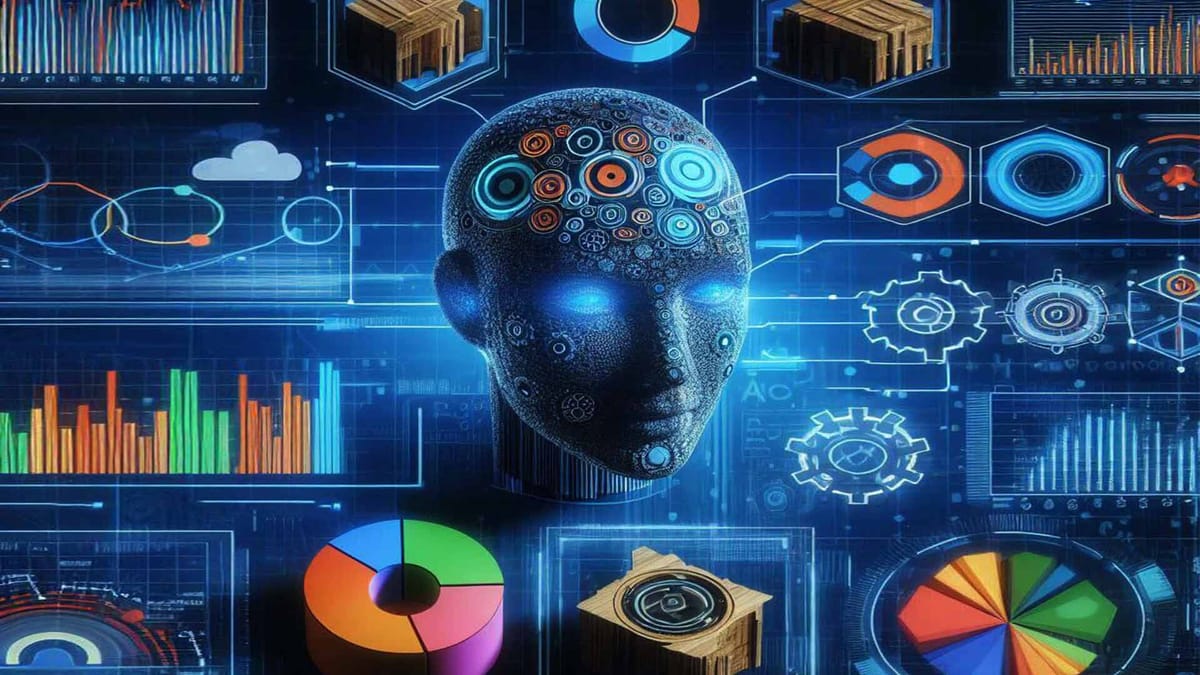Using AI Models for Effective Customer Segmentation

The old way of grouping customers is changing. AI model for customer segmentation starts a new era. It uses predictive analytics and real-time data analysis. These aren't just trends. They are essential for marketers who want to succeed. AI lets businesses offer personalized experiences, increase customer engagement, and see bigger ROI gains.
Old-school segmentation brings to mind spreadsheets and guesses. Almost half of marketers once relied on hunches. But AI changes the game. Sentiment analysis improves targeted marketing. It understands how customers feel about products and services. This shift makes marketing more effective, boosting engagements, sales, and keeping customers coming back.
Get ready to dive into using AI for creating detailed buyer profiles. Fine-tune your marketing to match market trends. Enjoy more agility in your planning with data-driven strategies. Say hello to custom marketing in the digital era.
Key Takeaways
- AI and machine learning make customer segmentation better and more accurate, leading to smarter choices.
- AI-driven customer segmentation keeps up with market changes better than old methods, giving you an advantage.
- Using sentiment analysis, companies understand customer emotions better for more effective targeted marketing.
- Predictive analytics and AI uncover patterns in customer behavior, improving future marketing plans.
- To use AI in segmentation, pick the right tools. Integrate and optimize them for the best results.
- AI might cost more at first, but it significantly boosts ROI and customer relationships over time.
The Evolution of Customer Segmentation: From Traditional to AI-Driven Techniques
The way we do customer segmentation has really changed. It went from old-school ways to new, AI-driven techniques. In the past, businesses used simple things like age, interests, and a bit of behavior to group their markets. These old ways had problems. They were slow, not always right, and too simple to really get how customers change.
Now, AI technology has changed the game in understanding customers. It uses predictive analytics and looks deep into behavior. This means businesses can get super detailed insights for better marketing. These data-driven ways are quicker and sharper. They use fresh data to keep up with how the market changes.
AI has changed static ways into flexible strategies. It uses data like shopping history and what people say on social media to guess what they’ll do next. This helps companies make offers that really hit home with each person.
With AI, customer profiling gets even better. It builds detailed profiles that keep getting updated. This leads to really personalized marketing, a key move today. AI makes segmentation both responsive and ahead of the curve. It guesses what customers will need or want before they even say it.
Shifting to AI for segmentation makes everything more efficient. It takes over routine jobs so marketers can think up new ideas. Plus, it helps make smarter choices because it's based on solid data. This matches up well with what the business and its customers are looking for.
The Mechanics Behind AI-Powered Customer Segmentation
Artificial intelligence (AI) is changing marketing strategies by making them more personal and dynamic. Through machine learning clustering and AI segmentation, businesses can analyze lots of data. This helps them find specific customer groups and improve their marketing plans.
Machine Learning Clustering in Action
Machine learning clustering is at the heart of AI segmentation. It's great at making sense of complex data and spotting natural groupings. This leads to dynamic segmentation, grouping customers by their current actions and likes rather than just who they are demographically. Predictive analytics also play a role in guessing future customer actions. This changes the way campaigns are both created and run.
Transforming Data into Consumer Insights
Natural language processing (NLP) boosts customer profiling by using AI. NLP looks at the way people talk in feedback, social media, and other communication. It understands public feelings and reactions toward products or services. This is key for making AI customer profiles that match what people currently need. It also makes targeted marketing more effective.
These advanced tools help businesses make decisions based on data. They also let companies engage with customers in a personal way. AI-driven segmentation lets marketing plans quickly adjust to new customer behaviors. This keeps marketing efforts both relevant and powerful.
AI helps make segmentation precise, moving away from guesses. Marketers can then meet customer needs faster and more accurately. This doesn't just make things more efficient; it also boosts ROI. Campaigns can target the groups most likely to make a purchase.
- Advanced algorithms enable predictive segmentation.
- Consumer insights drive strategy refinement.
- Behavioral data analysis informs dynamic advertising initiatives.
AI does more than just support decision making. It helps achieve better marketing results and a deeper market understanding.
Unlocking the Capabilities of AI Models for Customer Segmentation
The introduction of AI model for customer segmentation has changed the game in predicting customer behavior. Now, models use predictive analytics to foresee what customers will do next. This lets companies customize their strategies more effectively.
Thanks to AI segmentation tools, firms can now analyze customer data all the time and instantly. This means they can keep their segmentation up to date. AI models continually refine customer groups by looking at direct interactions and behavior patterns.
AI technology can break down huge datasets and offer useful tips for quick, smart choices. Using AI tools means companies can change their marketing as the market changes. This makes their marketing efforts more accurate and timely.
| Feature | Benefits | Impact |
|---|---|---|
| Real-time Data Analysis | Enables immediate insights and reactions to market behavior. | Enhances responsiveness and strategic agility. |
| Predictive Analytics | Forecasts future consumer behaviors and preferences. | Improves the relevance and efficiency of marketing campaigns. |
| Automated Data Collection | Collects and analyzes data continuously without human intervention. | Reduces errors and increases the speed of data processing. |
| Dynamic Segmentation | Adjusts customer segments based on real-time data. | Keeps marketing efforts aligned with current customer needs. |
Using AI tools for customer segmentation gives a detailed outlook on market trends. It also makes decision-making sharper. With AI, companies get insights on both large scale and small scope, leading to smarter marketing moves.
Comparing AI to Traditional Customer Segmentation Methods
Traditional customer segmentation focuses on demographics, but it struggles in today's fast-paced market. AI-powered segmentation fills this gap effectively. It not only reacts to trends but also forecasts changes, thanks to predictive analytics.
The Downsides of Demographic-Based Segmentation
Traditional methods sort consumers into broad categories, like age or income. However, they miss individual preferences. AI provides dynamic segmentation that catches these nuances, improving marketing and customer happiness.
Dynamic Segmentation: Adapting to Consumer Behavior
AI-driven segmentation is the future, changing as consumer behaviors do. It relies on detailed data for a deeper understanding of needs. Predictive analytics helps businesses foresee and act on future consumer actions, making marketing more targeted.
Switching to AI methods marks a big step forward in marketing. AI improves the analysis of customer behavior and detail in profiles. This enhances engagement and loyalty through tailored marketing.
| Feature | Traditional Segmentation | AI-Powered Segmentation |
|---|---|---|
| Data Processing Speed | Slow, batch processing | Real-time processing |
| Adaptability | Low | High |
| Behavior Forecasting | Limited predictive capabilities | Advanced predictive analytics |
| Customer Engagement | Generic | Highly personalized |
| Marketing Strategy | Static | Dynamic, data-driven |
How AI Models Reinforce Market Segmentation Analysis
Using AI for customer segmentation is now essential for market segmentation analysis. AI can deeply analyze large datasets. This lets us understand consumer behavior analysis and improve personalized marketing better than old methods.
AI can predict who will be your customers and what they will buy. This ability comes from AI’s role in daily marketing tasks. It ends the guesswork that 49% of marketers used to depend on. This strong analysis helps make marketing strategies better. It also keeps strategies up-to-date with consumers and market trends.
- Better ROI on marketing investments by accurate targeting and prediction of high-intent users which boosts conversions and retention.
- Enhanced understanding of customer churn, allowing preemptive action to improve customer loyalty and minimize losses.
- Identification of high-value customers or segments, which enables more focused marketing efforts and resource allocation.
AI does more than analyze data. It looks at data from different places for detailed segmentation and targeted marketing.
Advanced algorithms like k-means clustering make this better. They help understand consumer profiles better. This way, companies can meet needs and preferences ahead of time. Moving from reactive to proactive marketing greatly improves marketing success and customer happiness.
With AI, marketing strategies become very targeted. They're based on a deep, data-informed understanding of consumer groups. Customer segmentation with AI focuses on small details. This leads to better marketing adjustments and improvements.
By using AI to predict market trends or make real-time decisions, your brand stays ahead in innovation. Your marketing strategy becomes more current, predictive, and flexible.
The Practical Benefits of Applying AI in Customer Profiling
AI-driven customer profiling has changed the game for targeted marketing and consumer insights. It fine-tunes personalization and makes marketing campaigns hit the mark. This leads to marketing that really speaks to customers.
Enhanced Targeted Marketing Strategies
AI helps companies make detailed customer profiles. This gives them better consumer insights. These insights help talk to their audience more directly. Companies like Amazon and Netflix show how well this can work. They've seen better customer involvement and more sales with AI.
Predictive Analytics for Customer Behavior Forecasting
Predictive analytics gives a peek at future trends and behaviors. This lets companies shape their marketing for upcoming changes. They can engage customers early and keep them coming back. See how AI tools change marketing and customer views in the table below:
| Feature | Benefit | Example |
|---|---|---|
| Real-time Data Analysis | Enables dynamic adjustment to marketing campaigns | Continuous customer segmentation adjustments by AI systems |
| Advanced Algorithm Application | Identifies nuanced patterns for precise segmentation | Use of boosting tree algorithms for predictive modeling |
| Comprehensive Customer Profiling | Profiles provide deeper insight into consumer needs and preferences | RFM and LTV methods combined with AI for enhanced profiling |
| Behavior Forecasting | Predictive capabilities allow anticipation of future buying behaviors | Models by He and Li for enhancing customer lifetime value through behavior prediction |
| Social Network Analysis | Understands customer dynamics through social interactions | Social network analysis used for market understanding in Ballestar's model |
Using AI in customer profiling and analytics moves your business forward. It sharpens how you see and respond to customer changes. Your targeted marketing campaigns get better and more personal. This boosts customer happiness and loyalty.
Strategies for Implementing AI in Your Own Market Segmentation
Highly personalized marketing is in demand. This makes implementing AI in market segmentation a game-changer. Here’s a simple guide on using AI to improve your customer analysis and outreach.
First, it’s vital to understand your business needs. AI tools for customer behavior analysis can reveal what customers like and do. However, they need to be set up to focus on your goals. Figure out which customer data is key for you, like purchase history or feedback.
Gathering top-notch data is key. You should collect detailed customer info through your CRM and social media platforms. The better your data, the better your AI, like machine learning models, will work in understanding and predicting customer actions.
Choosing the right machine learning models is a must for success. These models sift through big data sets for targeted marketing. They also get smarter with more data. Pick models that analyze data in real time, so you can quickly react to changes and customer behavior.
| Data Type | Usage in AI Segmentation | Impact on Marketing |
|---|---|---|
| Demographic | Identify customer groups | Enhanced targeting accuracy |
| Transactional | Understand purchasing patterns | Personalized offers and promotions |
| Behavioral | Predict future actions | Increase engagement and loyalty |
| Psychographic | Develop detailed personas | Improved message resonance |
In summary, machine learning models and AI tools are key to getting and using deep insights into customer behavior. They allow businesses to not just meet but predict customer needs. This greatly improves your marketing impact and customer happiness.
Real-World Success Stories: AI Models Transforming Businesses
AI models have changed how industries like retail and e-commerce work. They show how AI helps us better understand customers, improve marketing, and boost business outcomes.
Case Studies in Retail, E-Commerce, and Beyond
Big retailers like Amazon and Walmart are using AI to improve how they sell things. They analyze customer data to manage stock better and create great shopping experiences. Amazon's custom solutions and Walmart's efforts to cut waste show how AI can change retail.
E-commerce sites are getting better at marketing thanks to AI. They use AI to look into big data and learn what customers like and want. This has led to more people engaging with sites and buying more.
Data-Driven Transformation in Marketing Outcomes
Predictive analytics help businesses make smarter decisions and plan marketing that meets customer expectations. Success in targeted marketing campaigns proves that AI can improve marketing strategies. This leads to better results.
With AI, companies can target customers more accurately. For example, one big retailer saw sales jump by 20% thanks to AI. They used tools that analyze customer behavior in real-time to tweak marketing efforts.
| Industry | AI Application | Outcome |
|---|---|---|
| Retail (Amazon) | Customized shopping experiences | Increase in customer satisfaction and sales |
| Retail (Walmart) | Inventory management using predictive analytics | Reduction in wastage, enhanced availability |
| E-commerce | Data-driven consumer insights | Higher engagement, increased sales |
| General Retail | AI-driven targeted marketing campaigns | 20% increase in sales |
Summary
The world of targeted marketing is changing. AI and machine learning have become key to understanding customers. By analyzing over 24,000 data points, techniques like k-means clustering help group customers effectively. This approach provides deep insights into your customer's needs and behaviors.
Machine learning, especially through algorithms like k-means, improves how we profile customers. It lets marketing campaigns adapt quickly to new trends. By finding natural groups in your customer data, you use methods like the elbow method to refine your marketing. This makes your messages more relevant and impactful.
Today, meeting customer expectations requires adaptability and smart strategies. Clustering models, powered by machine learning, offer this flexibility. They not only spot but also adapt to new consumer patterns. Using these insights helps your business stay agile and competitive. It's essential for success now and in the future.
FAQ
What are the benefits of using an AI model for customer segmentation?
AI models analyze data in real time and predict trends. They enhance targeted marketing for better ROI. Knowing how customers engage helps businesses make smart decisions for their marketing.
How has customer segmentation evolved with AI-driven techniques?
AI has shifted segmentation from old-school methods to dynamic, precise ones. It uses consumer insights and predictive data for better segmentation. This approach adjusts to changing consumer behaviors, offering deep customer insights.
What role does machine learning clustering play in AI-powered customer segmentation?
Machine learning clustering groups customers based on data patterns. It allows for insightful customer profiling through predictive and behavioral analysis. This helps in creating targeted marketing that really speaks to consumer needs.
In what ways do AI models transform data into consumer insights?
AI models dig deep into customer data to understand feelings and opinions. They use sentiment analysis and language processing to grasp consumer behavior. This knowledge supports marketing strategies that truly connect with consumers.
How do AI models compare to traditional customer segmentation methods?
AI models focus on real-time and adaptable segmentation. They quickly respond to consumer behavior changes. This speed allows businesses to adjust their marketing to stay effective and relevant.
What are some of the practical benefits of applying AI in customer profiling?
AI boosts targeted marketing and predicts customer actions. It offers insights into consumer patterns and preferences for better personalization. These strategies aid in keeping and gaining customers effectively.
What strategies should businesses consider when implementing AI in market segmentation?
To use AI in segmentation, collect diverse data and pick suitable machine learning models. Regularly check and tweak AI systems for best results. AI tools help refine engagement strategies and boost marketing success.
Can you provide examples of AI models transforming businesses in the real world?
In retail and e-commerce, AI predicts churn and identifies key customers. It boosts business by creating personalized experiences. This leads to more effective marketing campaigns and greater customer satisfaction.



Comments ()